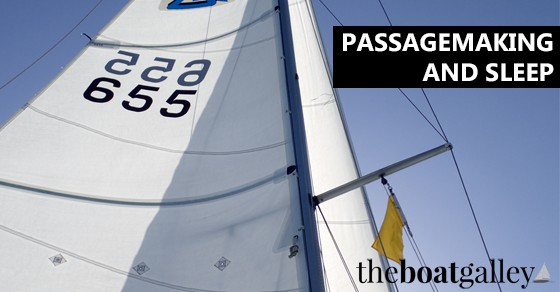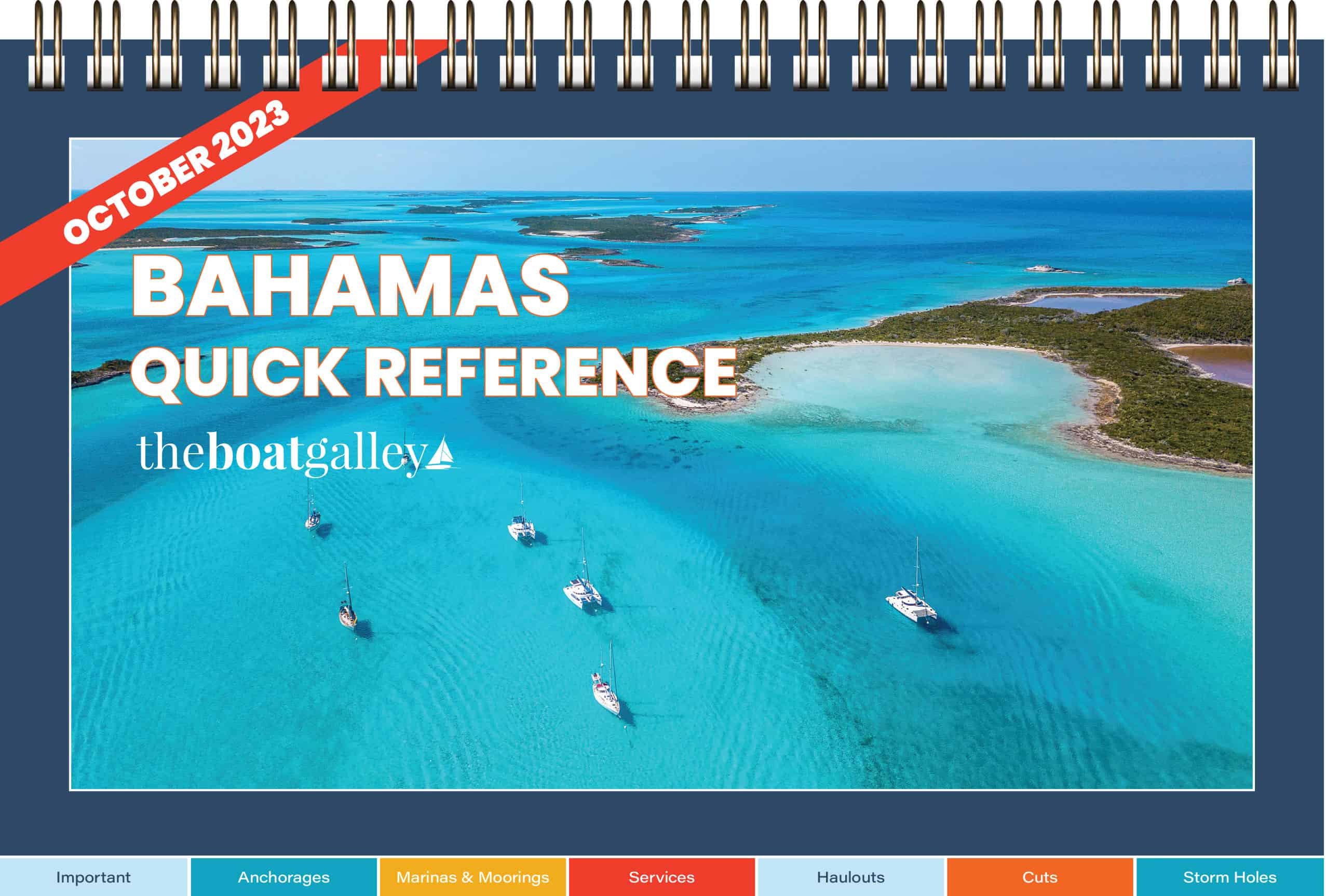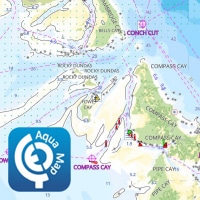Planning your first overnight passage? Wondering what it’ll really be like . . . and how you’ll sleep?
There are no universal answers, but I can pass on some tips from ours. And interestingly, we find that the keys to sleep don’t begin when we lay our head on the pillow, but well before.
Know that the Boat is Ready. Don’t just assume that the boat is ready, but check all the major systems. Every boat will have its own list, but common items include the following.
- Make sure bilge pumps work and the strainers are free of debris (and hair — the big culprit on boats).
- Test the EPIRB.
- Check the contents of the ditch bag. Make sure the life raft and ditch bag are accessible.
- Check the oil in the engine and the transmission fluid.
- Start the motor up and make sure that cooling water is circulating and the engine not overheating (the raw water intake can get blocked by bottom growth or debris sucked in).
- Clean the bottom of the boat.
- Have the jacklines in place.
- Create routes for the chartplotter and backup systems. Create alternate routes for bailout places. Research emergency stops.
- Water the batteries if using lead acid batteries.
- Turn on the radar and make sure it’s working — you don’t want to discover there’s a problem just as you need it.
Having confidence in the boat relieves a lot of stress — often stress that you don’t even realize is there. And stress takes away from the enjoyment of the passage as well as interferes with sleep.
Confidence in Other Watch Standers. Not everyone will be equally skilled or knowledgeable and that’s okay — we all had to start somewhere. But everyone has to have basic skills and the ability to do basic boat operations, as well as know when to call the others on board for assistance.
The basic skills can’t just be learned in an hour the day before a trip. And they can’t be learned just by reading. Day trips leading up to the overnight passage have to be used as training and practice sessions until everyone who will be taking a watch is comfortable with basic boat operations and also knowing when to ask for help.
We also have a set of “standard operating procedures” that we both agree to: we put in an extra reef before dark, we always wear our tethers, we never go on deck without the other person in the cockpit, and we never hesitate to wake the other one if there is the slightest question about anything. One other rule that Dave abides by (at the risk of too much information): no peeing overboard while alone on deck (seriously, this is one of the biggest causes of men going overboard when the boat hits a wave wrong).
Assuming that there is more than one of you, being comfortable with what the other person is doing is huge for being able to sleep. It’s funny, but knowing that Dave won’t hesitate to wake me (and vice versa) lets me sleep much better as I don’t feel like I have to keep “one ear open” for signs of a problem.
Start Well-Rested. It’s easy to get caught up in last-minute preparations or worry about whether you’re really ready and not sleep well the night before a passage. But starting out sleep deprived puts you in the hole to start with.
We learned to try to have all the big jobs done before the last day so that it’s just things like taking trash ashore, stowing the dinghy for passage and topping up water on the last day. I’ll also usually do some food prep, but we try to have everything done by late afternoon, then a nice dinner and just relaxing in the evening.
Keep Food Simple. My first couple of overnight passages, I seriously over-complicated our meals. I planned three large meals, including a “special dinner” to commemorate our first night out. With no real idea of what even “benign” offshore conditions would be like, I had no idea what would be appropriate. Planning to spend three hours cooking a single meal was just plain stupid. And exhausting.
Now, we’ve discovered that we eat more snacks — healthy snacks, not junk food — than real meals. Trail mix, single servings of fruit, yogurt, that kind of stuff. Once a day, if conditions aren’t bad, we have a meal together but keep it simple: if it’s hot out, a cold salad; if it’s cool, a pre-cooked dish that I warm up.
As you get more experience with passages, you may decide to carry ingredients for more elaborate meals and use them if conditions allow. But for the first few trips, while you’re figuring things out, keep it simple so that meal prep does not interfere with sleep time.
Quiet the Boat. As you are on watch, be aware of any “little noises” such as clanking glasses or rattling pans that could bother the person sleeping and — quietly — do what you can to stop them. Generally, stuffing rags into lockers is a quick fix. Change the settings (if necessary) on electronics so they don’t beep when buttons are pressed.
Sometimes, too, just a 5° course change can have a profound effect on the motion of the boat so that it’s easier for the off watch to sleep.
The Watch Schedule. You know your own body, how much sleep you need and how long you can be alert on watch. Many couples opt for either 3 or 4 hour watches in typical conditions.
Dave and I have discovered that we do far better with roughly 6-hour watches as we prefer more sleep in one stretch. That said, we are somewhat flexible in the watches — if the off watch is sleeping soundly and the person on watch is still feeling good, we may go a little long. If the off watch wakes early and there aren’t any jobs that have to be done, we’ll swap early. And if conditions are challenging — not just weather, but the amount of traffic or anything else — we may shorten the watches.
If we have an “all hands on deck” situation (generally a squall), we’ll rearrange the watch schedule when it’s over. We find that with just two of us, flexibility is key. Our time on watch equals out but generally doesn’t go exactly by the clock.
While we think of the person on watch as the one with responsibilities, the off watch has one important duty: to get sufficient rest that they are alert and ready to go when it is time for their watch. Even if you don’t think you can fall asleep, lie down and rest.
Plan for Drowsiness. Rather than assuming that the person on watch won’t get drowsy at 3 AM, plan for it. We each have a timer on our watch (but you can use any timer, although it’s best if it automatically repeats) and set it to 10 minutes. That way, if we do doze off, the alarm will wake us and prompt us to look around. Every time it goes off — day or night — it’s the signal to stand up and do a full 360° scan of the horizon. You don’t want to set it for much longer than 10 minutes, due to the speed with which cargo ships move! It’s also a good idea to use radar and AIS alarms if so equipped, but neither one is a substitute for slowly scanning the horizon every 10 minutes.
Sleep Deprivation is a Serious Problem. Exhaustion leads to bad decisions and bad decisions lead to injuries and boat damage. What should be minor problems become cascading disasters. Charts are impossible to decipher. After a few days, hallucinations can start (read about the space chimp that visited my friend and fellow Boat Radio podcaster John Herlig). Others have written about hearing voices or seeing people.
One of our hard and fast rules is that we don’t enter unfamiliar harbors after dark, no matter how tired we are. We know that at the end of a trip, we’re tired and probably not thinking and reacting as well as we should. It’s easy to run aground, get confused as to where we need to go, or just “not see” traffic in a busy harbor.
So we slow down to arrive after sunrise, heave-to, or just circle outside a channel. Not fun and it adds more hours to the trip. But we think it’s safer to approach during daylight when we’re tired.
I certainly don’t have all the answers and while I’ve done numerous two- to four-day passages, I haven’t done any longer than that. And only two of mine have included sustained winds over 30 knots. We’ve been tired when we hit land, but never totally exhausted. Please add your own tips for getting sufficient sleep on overnight passages.

Quickly find anchorages, services, bridges, and more with our topic-focused, easy-to-use waterproof guides. Covering the ICW, Bahamas, Florida, and Chesapeake.
Explore All Guides

Carolyn Shearlock has lived aboard full-time for 17 years, splitting her time between a Tayana 37 monohull and a Gemini 105 catamaran. She’s cruised over 14,000 miles, from Pacific Mexico and Central America to Florida and the Bahamas, gaining firsthand experience with the joys and challenges of life on the water.
Through The Boat Galley, Carolyn has helped thousands of people explore, prepare for, and enjoy life afloat. She shares her expertise as an instructor at Cruisers University, in leading boating publications, and through her bestselling book, The Boat Galley Cookbook. She is passionate about helping others embark on their liveaboard journey—making life on the water simpler, safer, and more enjoyable.











Roger Johnson says
I always appreciate your tips? Thank you!
Deb Jansma says
It’s great to hear someone else who does more than 2 or 3 hrs watches. We tried that one time, and then went to 5 hr watches.
Jan Drury says
We do 6 and 6 – always works for us
Steve Olson says
I will soon be installing this: http://www.sailsafely.com/
Melvin Bellwood says
We first tried 2 hour shifts with 20 minute alarm to survey the surroundings.
Was not enough time to rest. 4 to 6 depending on total length of trio planned.
10 minutes for the alarm would be good.
Patricia A. McLeod says
This is our next goal! Can’t wait
Dave Skolnick (S/V Auspicious) says
It is good to see your emphasis on rest and not watch duration. That is truly critical. Longer watches are key. I run 4-on/8-off on delivery. For couples cruising 6-hour watches are very reasonable.
One thing Carolyn did not address is putting things away. “Stuff” that stays put on day hops and at anchor may launch themselves across the boat on a longer trip. Put things away. All of them.
If you’re off on a passage or even just a hop time of day doesn’t count. As carolyn points out don’t leave when you are tired. When you are ready to go put everyone (*grin*) for a nap. So what if you leave at 10p or 3a?
For rattles, there is little that works better than toilet paper.
If you’re really heading off on a passage as opposed to an offshore hop consider taking on crew.
Mark Krajcar says
Watch schedules are a personal thing and it depends on how many are on board.. I delivered boats for 15 years and found what works best for me and my crews was 2 hours on, 6 off. Pretty much no matter how exhausted you are, you can stay up for 2 hours where sometimes 3 or 4 hours just isn’t possible. With just 2 of us we start the watch at 4 hours each then move to 2 hours. Watches start just before dusk and land last until just after sunrise/breakfast. During the rest of the day there is no formal watch schedule. Whoever wants to take a watch can and rarely does anyone have to ask to be relieved. This allows people the flexibility to grab a nap, shower, food, downtime as they need it and made for happier trips. Some of us know that we get our “best” sleep between certain hours and every effort should be made to schedule watches to include that timing.
cyndy says
I did a 24 day passage with only 2 people. We started at 3 & 3. By day 5 I said “I have got to go down for a solid 6. Can you handle that in the middle of the day because I am going to take an antihistamine and sleep? We discussed it and decided that we would go to 3&3 except I would take a 4-5 hour in the middle of the night, rest for 2 hours and then do 2 while the weather report came in (shameless plug for Chris Parker). If I was alert, I would take the entire 8 and then I would go down for as long as I could sleep, usually 6 hours. Very fluid but it worked for us. You have to do what works for the crew.
I did hear voices. There were little girls giggling – but when I asked about it I found out that the original owners of the boat had 3 little girls! I never heard them on watch, only in what I found out was actually the berth they slept in.
I once got called to the deck mid off watch. I arrived wearing nothing but my PFD but things got sorted and I went back to my berth and rested for the rest of my off watch.
Keeping to one scheduled meal per day also worked well for us. It gave us a chance to discuss what was and was not working (the head was different from mine and I wasn’t operating it properly until day 7) One cooked the other took galley clean up.
The owner of the boat made a 4 course meal for Thanksgiving Day and we had wonderful leftovers for a couple of days.
I have to say that only after the 4th or 5th day did a rhythm set in and then it became very easy. Now I really don’t like 2 or 3 day passages because there is no rhythm and it makes me more tired than longer passages.
As Mark says keeping things cleaned up makes a huge difference!
Kim Hall says
Returning to the sea life after 28 years on land I have been enjoying your tips and information to remind my husband and I of all the ins and outs we may have forgotten and things we may not have had or known about years ago.
Thank you for the tips and informative blog!
Seo says
I spent 20 plus years re-building and sailing a 50 ft ketch with two transatlantics amd throughout the Caribbean. While sometimes with a crew or friends, much of it solo. Sailing through the Gulfstream was always a challenge trying to keep out of the way of Tankers and long line fishermen. Add to it, I generally. Made the crossing at night. Try.as Imay, getting sleep before the start was nearly impossible and the first stretch was almost 18 hours till anchoring at Great SaleKey for some sleep. Sleeping became a serious problem. From sighting to impact a freighter at night is about 12 minutes away. So, I. Would set the Radar for alarms at 7 and 4 miles to ring. I then would of course set My night running lights and an alarm cloct for ten minutes and lay on the center cockpit and sleep with My safety line attached.
I remember when I was awakened by the radar on more than one occasion. Since most of the freighters are running at 14 to 18 knots and the watch on them are generally asleep, being 7 miles away is very close. Even if the were to hit me, the man on watch would never know it at night. So, sleep yes, but rest with safety alarms.
Of course many are not solo sailing but when the occasion arises, it’s awonderful experience. Sail safe and forever.
Seo
David NORMAN says
In designing a “watch system” there are a number of issues that need addressing. Firstly, no one wants to be saddled with the same boring and sometimes cold early morning watch day after day. Secondly, the body needs sufficient time to recharge its self. Watch systems also need to take account of how many crew are on board and their relative experience.
With two(2) crew i have found that 3hrs on and off during the night and 6hrs on and off during the day allows the crew to rotate through each day. This watch system allows enough time to get a decent rest/sleep during the 6hrs off.
With three(3) crew each person has 3hrs on, 3 hrs on standby (resting/ sleeping below and 3hrs hrs off, noting that when you are off you are off watch. This watch system will at most times provide a decent period in most days to sleep and recover as well as providing a watch rotation throughout the day.
Ocean Going Cat from “down under”
Molly on S/V Sabai says
Carolyn’s advice for 2 sailors is good: flexibility is key. We find that 3 on/3 off works well for us during the night and we can change that during the day if it helps. We used to do the “I’ll tough it out as long as I can method” which was a really bad idea. It led to much more fatigued and grumpy sailors. I’ve been doing the timer watch set at 10 minute intervals for over 20 years and it is really helpful.
Cathy says
Thank you for your great article! My first real sailing experience was two weeks in the Pacific Ocean and I sure wish I’d found this article back then. A friend was looking for crew and suggested I take sailing lessons – so I did. Then just 2 months later I’m sailing from Cabo San Lucas to Socorro Island and then on the La Cruz Mexico. I found out real quick that sailing lessons did not prepare me for life on a boat! But I did it! I must have done okay because this last spring he asked me to crew for him again on a 2 week cruise from Acapulco to Puerto Chiapas – I was his only crew. I’m 72 years old and have only sailed twice but they were both blue water sailing for a total of 4 weeks! Can’t wait to do it again!
Mary says
Carolyn, you sailed around the world but your longest passage was four days? How’s that possible?
Carolyn Shearlock says
No, I have not circumnavigated. Cruised the Pacific coast of Mexico, Sea of Cortez down to El Salvador. Then Florida and the Bahamas, with charters in Alaska, Turkey, USVI, BVI and Spanish VI.
Carol Freeland says
I had to re-read this today as my husband and I are doing a circumnavigation of Anacapa and Santa Cruz islands at night to gain skills for a longer passage! Thanks for all the tips
Bob says
Try 5/7 and 7/5. This way you get 6 hours of uninterrupted sleep and minimize fatigue. 6 and 6 always looks good but you will never get 6 hours of uninterrupted sleep
Leonie Deramus says
5 years ago we bought a 45ft Jeanneau in Lisbon,Portugal and sailed her all the way to New Zealand. Mostly just the two of us but crew of 5 for the 20 + days across Atlantic and Pacific.
My husband is the experienced longtime sailor. I am a good first mate but no captain and sleep is vital for me.
This is how we manage : Definitely take on experienced crew for any passage longer than a week. If it’s just the two of us and weather permits we both sleep ( tethered of course) on the benches in the cockpit and do roughly 3 hr watches during the night while staying flexible.
I listen to podcasts while on watch and scan horizon and chart plotter every 10-15 minutes.
Having my skipper sleep next to me gives me peace of mind though I very rarely haven to wake him.
Carolyn‘s advice is spot on . Always reef before nightfall and never , ever be on deck without PFD and tether when passage making.